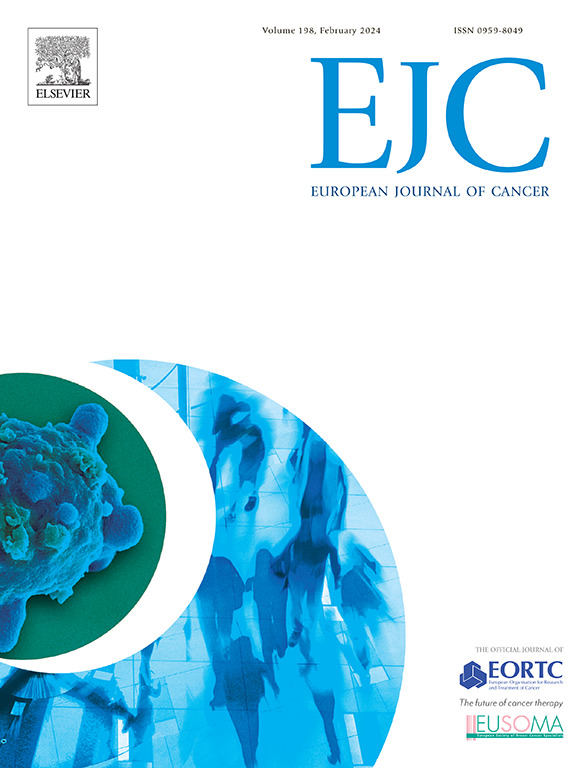Specific targeting of the pseudogene RPSAP52 reduces ovarian tumor growth in patient-derived orthoxenograft models
IF 7.1
1区 医学
Q1 ONCOLOGY
引用次数: 0
Abstract
The RPSAP52 pseudogene is transcribed in the opposite direction to the oncofetal gene HMGA2 and is reexpressed in various human cancers. Here, we investigate the impact of RPSAP52 in ovarian cancer (OC) and explore the potential therapeutic application of GapmeR antisense oligonucleotides against RPSAP52 in preclinical models. RPSAP52 and HMGA2 expression were investigated in TCGA for OC and further explored in a panel of orthotopic PDXs and commercial cell lines by RT-qPCR. The Kaplan–Meier method was used to estimate survival associated with RPSAP52 expression in a dataset within the OC TCGA cohort. The effect of specific silencing of RPSAP52 on tumor growth in vitro and in vivo was evaluated by lentiviral-mediated depletion and antisense LNA GapmeRs against RPSAP52. The pseudogene RPSAP52 was overexpressed in epithelial OC in both patient samples and OC preclinical models coinciding with the overexpression of HMGA2. Elevated expression levels of RPSAP52 in the early stages of OC were associated with poorer clinical outcomes and could stratify patients in stages I and II. The specific depletion of RPSAP52 led to a reduction in OC tumor growth in vitro and in vivo. Furthermore, the treatment with antisense LNA GapmeRs against RPSAP52 showed significant antitumoral effect in OC cell lines and in a PDOX model (without evident toxicity). Our findings demonstrate that RPSAP52 displays pro-growth features in OC, underscoring the significance of pseudogenes in cancer pathophysiology. This pseudogene has potential utility as therapeutic target in OC and as valuable prognostic biomarker for the early stages of this disease.
假基因RPSAP52的特异性靶向降低了患者来源的原位移植模型中卵巢肿瘤的生长
RPSAP52假基因的转录方向与癌胎基因HMGA2相反,并在各种人类癌症中重新表达。在此,我们研究了RPSAP52在卵巢癌(OC)中的作用,并在临床前模型中探讨了GapmeR反义寡核苷酸对RPSAP52的潜在治疗应用。RPSAP52和HMGA2在OC的TCGA中表达,并通过RT-qPCR在原位pdx和商业细胞系中进一步研究。在OC TCGA队列的数据集中,使用Kaplan-Meier方法估计与RPSAP52表达相关的生存率。通过慢病毒介导的耗尽和针对RPSAP52的反义LNA GapmeRs,在体外和体内评估RPSAP52特异性沉默对肿瘤生长的影响。在患者样本和OC临床前模型中,假基因RPSAP52在上皮OC中过表达,与HMGA2过表达一致。RPSAP52在OC早期表达水平升高与较差的临床预后相关,并可将患者分为I期和II期。RPSAP52的特异性缺失导致体外和体内OC肿瘤生长减少。此外,反义LNA GapmeRs对RPSAP52的处理在OC细胞系和PDOX模型中显示出显著的抗肿瘤作用(无明显毒性)。我们的研究结果表明,RPSAP52在OC中表现出促生长特征,强调了假基因在癌症病理生理中的重要性。该假基因具有潜在的效用,可作为卵巢癌的治疗靶点和该病早期有价值的预后生物标志物。
本文章由计算机程序翻译,如有差异,请以英文原文为准。
求助全文
约1分钟内获得全文
求助全文
来源期刊

European Journal of Cancer
医学-肿瘤学
CiteScore
11.50
自引率
4.80%
发文量
953
审稿时长
23 days
期刊介绍:
The European Journal of Cancer (EJC) serves as a comprehensive platform integrating preclinical, digital, translational, and clinical research across the spectrum of cancer. From epidemiology, carcinogenesis, and biology to groundbreaking innovations in cancer treatment and patient care, the journal covers a wide array of topics. We publish original research, reviews, previews, editorial comments, and correspondence, fostering dialogue and advancement in the fight against cancer. Join us in our mission to drive progress and improve outcomes in cancer research and patient care.
 求助内容:
求助内容: 应助结果提醒方式:
应助结果提醒方式:


